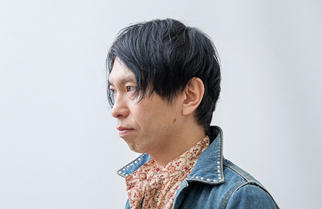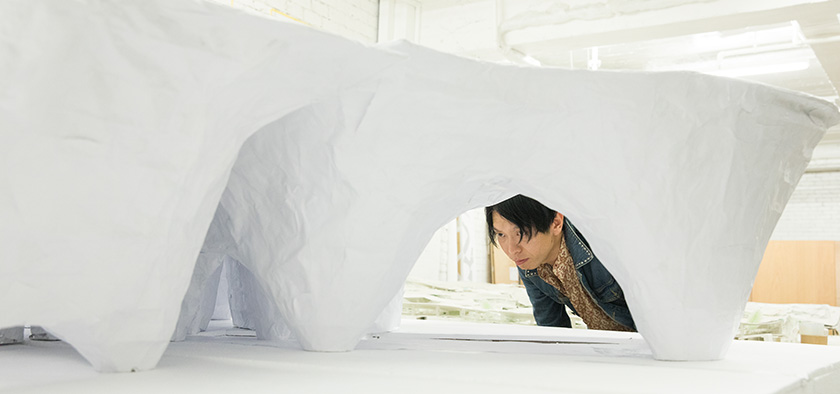
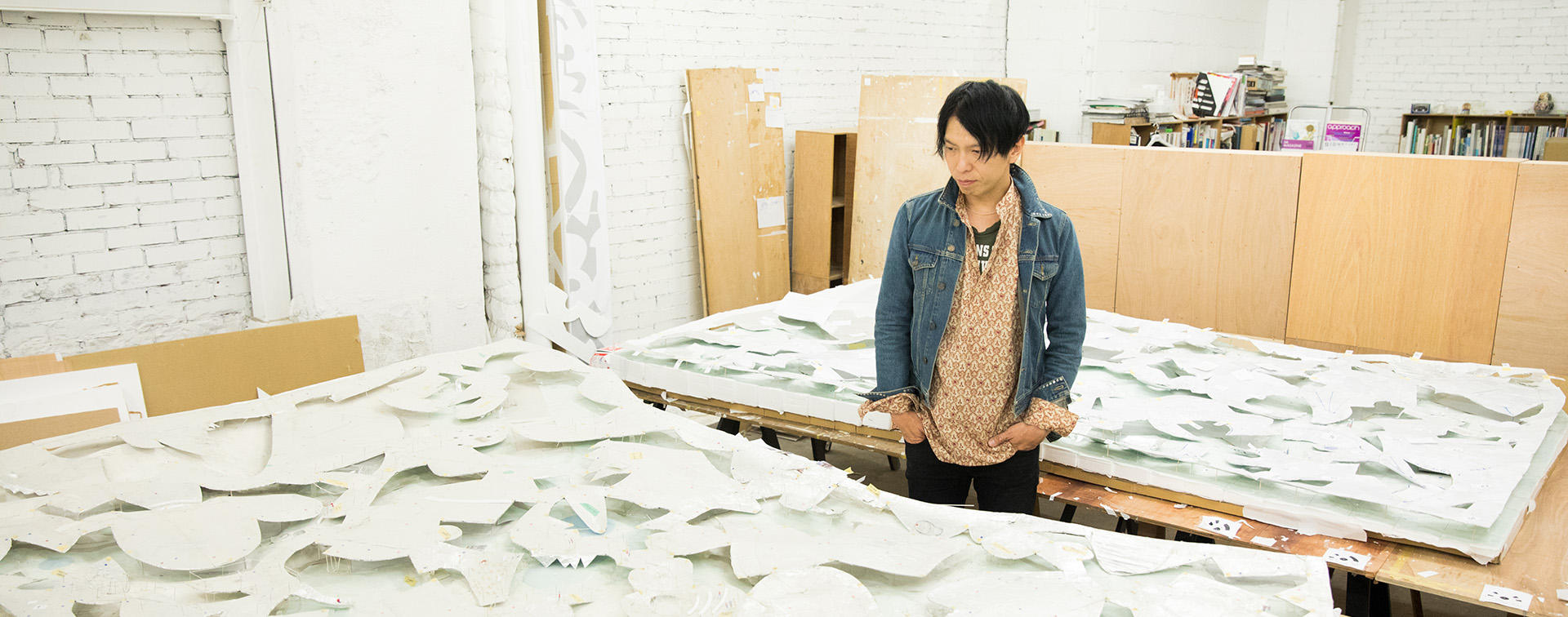
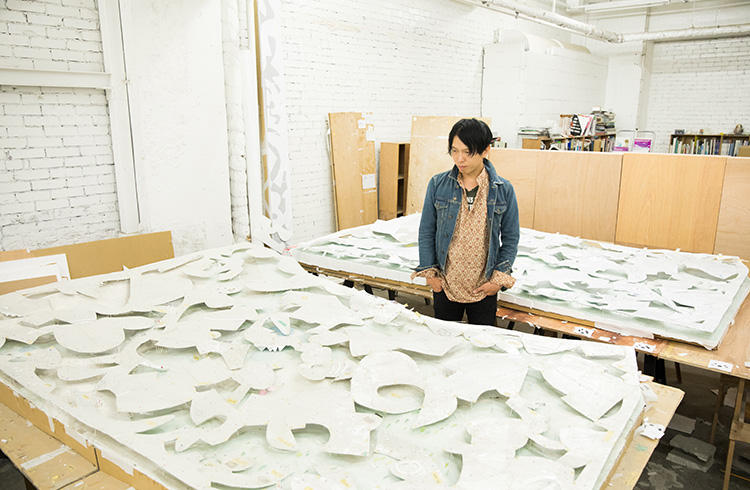
City development of the future will involve thinking about scenery
A work becomes realistic when it incorporates everyday life
Junya Ishigami is an architect who creates architecture in unlikely places, creating shapes and spaces that look peculiar, and yet are most suited to each region and brings out its charm. The exhibition "Junya Ishigami, Freeing Architecture" being held in Paris at the Fondation Cartier pour l'art contemporain has won high acclaim, and a decision was recently made to extend the exhibition to September. We asked Ishigami about his vision of future cities, and also about what is needed for Roppongi to become an area of art and design.
An office that blends in with the atmosphere of Roppongi
My works are currently being shown at Mori Art Museum's "Japan in Architecture: Genealogies of Its Transformation" exhibition, and my office is in Roppongi, so I have ties to Roppongi. I moved my office to Roppongi because there happened to be a building that filled all my requirements. You could say it is by coincidence that I came here. By making Roppongi my headquarters, I made some unexpected discoveries. The landscape is more sloped than I imagined, there is more greenery than I thought, and there are remnants of the area structure of the old days. It's a place that is fun to walk around. Also, there are many people from abroad at my office, and because Roppongi is a place of different races and cultures, we seem to be blending in.

"Japan in Architecture: Genealogies of Its Transformation" exhibition
Held April 25 (Wed) - September 17 (Mon), 2018 at Mori Art Museum. On exhibit is a concrete model of a housing and restaurant project called "House & Restaurant" that is currently being developed in Ube City, Yamaguchi Prefecture.
House & Restaurant
© junya.ishigami+associates
I think Roppongi would have a brighter atmosphere if it didn't have the elevated Tokyo Metropolitan Expressway. When you hear the name Roppongi, the sight of the intersection with "Roppongi" written on it comes to mind, doesn't it? Maybe it would be difficult to implement, but if we could remove that elevated expressway, the sunlight would be unobstructed, and Roppongi will become a sun-filled place with a dramatically different atmosphere. However, when I'm speeding by in a car on the expressway, it feels good. (laughs)
Utilizing Japan's landscape-based city structures
I think the city structure of Tokyo differs from other cities in that its history is connected to its land features. For example, the area around Roppongi, being at the top of a hill, was originally a residential area with grand old houses on spacious compounds. Meanwhile, the valley areas have traditionally been the commercial, shopping districts; the town structure here has not changed since the Edo era. On the other hand, in Europe, in particular, city and building structures are not related to the land features. A structure of a city is developed through city blocks and is dependent on how the buildings are lined up. The difference between cities in Japan and Europe is that if all the buildings in a European city were to disappear, the atmosphere of the city itself would almost all be gone, but in Japan, because the land features are the same, the atmosphere of the city would be retained even if the buildings were changed.
While the original landscape may remain, it's necessary for a city to update itself in line with the changes in people's values. I think a city structure that takes good advantage of a landscape is one where the history can be felt in the scenery. So a city needs to be renewed by taking into consideration the scale of the original land features. For example, there are many slopes in Tokyo, and in the past when there were no big buildings, these slopes were like monuments or landmarks of the region; that's why slopes that existed from long ago have names that speak of the atmosphere of the place. There are slopes called Kurayami-zaka (Darkness slope), Keyaki-zaka (Japanese Zelkova tree slope) and Nadare-zaka (Tilting slope). Tokyo is probably the only city in the world which has so many slopes with names.
I think it's important, particularly in Tokyo, to think about an area along with the memories of sceneries. Many old buildings have been lost due to air raids and earthquakes, but I think that by preserving the landscape, we can maintain the atmosphere that remains in an area. That's something we need to consider when doing big developments; we also need to get the scale right, and properly analyze the land features.
Continuously create cities through buildings that are connected to the region
For me, it's important to think about living environments for people without making clear definitions about or drawing boundaries between developing cities, constructing buildings, and creating landscapes. Instead of starting with city planning, then forming the land in line with the plan, and then designing buildings for the newly-formed land features, I think it's better to come up with methods that are free from established hierarchal systems and procedures.
For example, we could first make the buildings, and then later change the land features a little to improve the environment. That way, discoveries are made which would not have been made with conventional city planning, and which can lead to slight revisions. Then we could make more buildings based on new city planning and the environment. And we could keep repeating that in a speedy way. Each part of the city develops differently and is intricately linked to the other parts, and the city as a whole grows spontaneously. Of course, this would be considerably difficult under current regulations, but I think it's necessary to have flexibility and to maintain the environment of a place at its many levels, and at the same time, to bring about change.
Technology is evolving, and perhaps in the near future, a new development method will be born where the system can be changed each time, processing all the complicated data. The scale of development projects is getting bigger and projects are being more speedily undertaken now; what is necessary for future development is the ability to deeply analyze the huge data concerning a certain place and to give it contemporary value. Sometimes, I feel that with simply large-scale and high-speed development methods, massive, hollow spaces with very little substance are being created in the middle of cities. That approach seems to belong to the past - it seems very 20th century to me. I think that in the future, city development will not be about erasing the history of a place and changing it drastically, but about transcending the past and the future, and linking the various elements with data and the environment, giving the place a complex connectivity.

Preserving history and atmosphere enhances the potential of a city
In an age where it is becoming possible to connect with anyone and to easily go anywhere, I think the uniqueness of each locality is becoming increasingly important. In the early stages of globalization, there seemed to be the goal of having the same values in all the cities around the world, with similar-looking large, modern, shiny buildings. Even now, such development projects are still being made in many places in the world, but I feel that we are beginning to shift to the next stage.
When you see a person you are connected with living in an environment you don't know, you feel envious and get the urge to go there yourself. Having that urge is important. If all the streets in the world looked similar, people will not even feel the urge to go somewhere else. There may be many reasons for wanting to move, but I believe that the desire to move and see places you haven't seen before and don't know about is an important driving force. In order to attract all kinds of companies, perhaps it is necessary to have a lot of modern buildings, but in a world where globalization has advanced, I think that workforce mobility will not be encouraged by modern buildings alone.
In other words, in a world that has become connected, the distinctive personality of each place has powerful value. And maybe it's not enough just to preserve a place as it is.
We need to first think about the history and culture of a place and dig deep, and then merge the distinctive elements of the place with contemporary values; we need to increase the potential of a place by enhancing its existing identity, and keep redefining its ideal state.
From now on, the key to city development will be to not just preserve, but to give a dynamic, deep energy to each place by rethinking its ideal state many times at tremendous speed, ad infinitum.
A space to create art that is integrated with everyday life
Roppongi is in the heart of Tokyo, and has an environment for attracting all kinds of things from around the world and showcasing them. But if you want to liven up Roppongi through art, I think it's necessary for artists to live here. There is no sense of reality unless people can see both the artists' activities and their art. In New York for example, many artists used to live in Soho and now they live in Brooklyn, and their lifestyle in those certain neighborhoods are inseparable from what they create. Unless the lifestyles of artists are integrated with their work, a place will become just an exhibition space or a trade show, and culture will not be born. I feel it's vital to have a place where real artistic activities can take place and where artists can delve into their creativity from their everyday lives.
However, simply creating spaces like artists' residences will not be the total solution. Of course, it might be necessary to do a certain amount of promotion, but for things to continue on a long-term basis, it's necessary to also offer potential within the city so that instead of luring artists by giving them things, artists will want to gather here of their own accord.
When the lives of artists become vibrantly rooted in the locality, they will create art and designs that naturally seem very Tokyo or very Roppongi. I think that in a certain way, the art museums and art galleries in Roppongi are properly playing their part, but aside from that, it would be good if art could be created here - art that is not transported from some other place. It would be wonderful if that could happen right in the middle of Ropppongi.
Actualizing ideas is more important than coming up with ideas
Of course it's important that the originality of a work reflects something that comes from within the person who made it. Yet I feel that a work cannot be compelling unless it also is a work that has resulted from the various elements that exist outside the person.
For example, I am drawn to works that seem to naturally reflect the artist's outer environment such as the place he or she was born and raised in, or the current place of residence or the artist's relationships with other people. In my case, since I do architecture, I feel that the source of creativity lies in the place and the land, or in what the client already has. The answers that appear are different each time because they depend on the identity of a place and the personality of the client; I feel when you carefully and sensitively look at all the outside elements, piling them up together and avoiding making any shortcuts, you end up with something that is original. It's important not to make shortcuts - even with things that normally can be eliminated. And when the elements pile up, the result is something that is inevitably different from the norm.
To put it bluntly, I am not attracted to "closed ideas" or things that suddenly appear unexpectedly and have no connection to the other things. I think that anyone can come up with ideas. Nowadays, it's easy to access all the different ideas that all kinds of people have come up with, and I don't think the ideas themselves are very inspiring. What's important is adapting the ideas to the real world, putting the ideas into a realistic context, and actualizing them. We live in an age of information, but there is a sense of wonder that fills the heart when you see real scenery in front of your eyes. So I believe it's important to have reality in mind when creating things and to give them shape in reality.
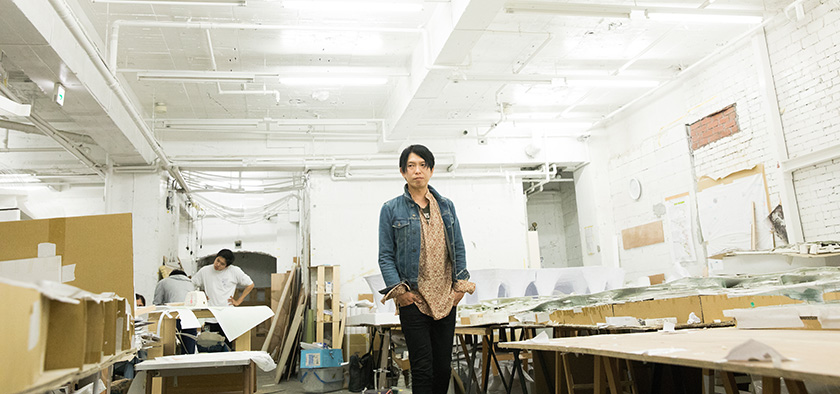
Creating architecture that everyone can accept
Some of the works shown at the "Junya Ishigami, Freeing Architecture" exhibition at the Fondation Cartier pour l'art contemporain may seem outlandish, but they seem so, only when viewed without an understanding of the context of the project. When you look at each one very closely and understand the project, the works will appear very natural and inevitable. The process of turning something strong and seemingly unnatural into something which looks as natural as possible and which everyone can accept, is very important for me; most of the energy I put into my work is poured into that process. One example is the KAIT workshop at the Kanagawa Institute of Technology. In that project, I tried to create both the structure and the space by using thin and narrow pillars.
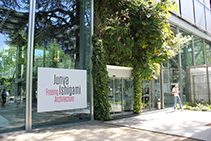
"Junya Ishigami, Freeing Architecture" exhibition
Junya Ishigami's solo exhibition which opened March 30, 2018 at the Fondation Cartier pour l'art contemporain in Paris. It was originally scheduled to be held until June, but due to popularity, was extended to September 9. Focusing on 20 of the architectural projects that Ishigami has undertaken in Asia and Europe, the exhibition shows images, drawing and models. It is the first time for the foundation to hold an exhibition on one architect.
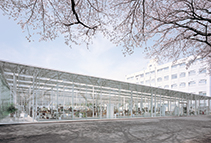
KAIT
A workshop at the Kanagawa Institute of Technology where students can freely experiment with making things. It was the first architecture that Ishigami designed after setting up his own office. His innovative creativity was recognized and he was awarded the AIJ (Architectural Institute of Japan) Prize and BCS (Building Contractors Society) Prize. The pillars of the building evoke trees in a forest. Ishigami describes the architecture as follows: "More than 300 thin and narrow pillars support the whole structure. There are no walls. At first glance, the pillars have the appearance of being randomly placed, but their positions are not random. Their positions have been meticulously calculated. Using models, experiments were made with all kinds of angles to determine the position of the pillars, and everything was recorded. That process was repeated many times. What we see here is a result of the countless studies that were undertaken."
KAIT Workshop
© junya.ishigami+associates
While the idea was to create architecture using a lot of pillars, I didn't want to end up with a building which would make people feel there were too many annoying pillars. So while the concept was for a building with numerous pillars, I thought hard about using as few as possible. I wanted a fairly large number of pillars to take advantage of their benefits, but at the same time, I calculated the minimum possible number. When you look at the photograph of the workshop, it might seem as if there are many pillars, but when you actually go into the building, you will not be bothered by their presence.
It's important to transform something that may be very extreme into something that anyone can accept. Personal computers and cell phones are like that. Before you realized it, it was the norm for everyone to have them. It may not be easy to make things that fit so smoothly in people's everyday lives, but rather than having a revolutionary force that completely changes the world overnight, I think that in this day and age, there is more strength in the sort of change that seeps through society and is accepted by everybody before you realize it.
Maximizing the potential of cities, places and buildings
In Russia, I was given the opportunity to do work on the extension and renovation of the Moscow Polytechnic Museum. Since it is a historical building, demolishing it was out of the question. It is a good thing to make use of existing buildings - to preserve them and to maintain their potential - but there were difficulties. For example, there would have been very few legal obstacles if we had done the contrived kind of renovation of covering the old building with a new building. With that method, the old building can always be restored to its former state by demolishing the new building that covers it. But when you do that, a building's appearance and atmosphere are completely changed and spoiled. That kind of renovation is more about keeping the building away from damage, rather than maintaining its original atmosphere.
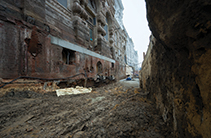
Polytechnic Museum, Moscow
Ishigami won the competition for the renovation of Polytechnic Museum, Moscow and the project was completed in 2016. A public space accessible to the local people was made under the concept of creating "a garden-like art museum." A museum park with a transparent roof was made underground, linking it seamlessly with the surrounding environment. Ishigami's innovative idea surprised many people.
Polytechnic Museum
© junya.ishigami+associates
Of course, I can understand the thinking behind that kind of renovation, but I believe the questions we really need to seriously ask ourselves are: How can we enhance the potential of old buildings while maintaining their atmosphere? How can we preserve the old atmosphere and at the same time make it match modern values?
The potential of architecture is about further enhancing the real possibilities in the real world. We live in an age where we can make all kinds of things on PCs and cell phones, uninhibited by place of time. The role of architecture is to enhance site-specific potential - potential that can only be realized in a certain time and place. Buildings cannot move. But it is their very lack of mobility that gives birth to possibilities and I want to continue thinking about them.
Editor's thoughts
Exhibitions on Ishigami's works have been held two years in a row: the "Grand Projects: How far will you go?" exhibition at 21_21 DESIGN SIGHT in 2017, and the "Japan in Architecture: Genealogies of Its Transformation" exhibition at Mori Art Museum in 2018. Since Ishigami-san's office is in Roppongi, I presumed he must know a lot about Ropppongi restaurants, but he told us that he does not dine out much here. "There is a bar I'm fond of though," he said. Just as I had imagined, Ishigami-san was a smart, stylish person.




